Engage NY Eureka Math Geometry Module 1 Lesson 25 Answer Key
Eureka Math Geometry Module 1 Lesson 25 Example Answer Key
Examples
Example 1.
Given: \(\overline{B C}\) ⊥\(\overline{C D}\) , \(\overline{A B}\) ⊥\(\overline{A D}\) , m∠1=m∠2
Prove: △BCD≅ △BAD

Answer:
m∠1=m∠2 Given
\(\overline{A B}\) ⊥\(\overline{A D}\) Given
\(\overline{B C}\) ⊥\(\overline{C D}\) Given
BD=BD Reflexive property
m∠1+m∠CDB=180° Linear pairs form supplementary angles.
m∠2+m∠ADB=180° Linear pairs form supplementary angles.
m∠CDB=m∠ADB If two angles are equal in measure, then their supplements are equal in measure.
m∠BCD=m∠BAD=90° Definition of perpendicular line segments
△BCD≅ △BAD AAS
Example 2.
Given: \(\overline{A D}\) ⊥\(\overline{B D}\) , \(\overline{B D}\) ⊥\(\overline{B C}\) , AB=CD
Prove: △ABD≅ △ CDB
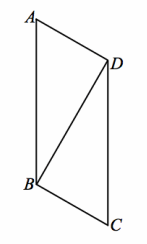
Answer:
\(\overline{A D}\) ⊥\(\overline{B D}\) Given
\(\overline{B D}\) ⊥\(\overline{B C}\) Given
△ABD is a right triangle. Definition of perpendicular line segments
△CDB is a right triangle. Definition of perpendicular line segments
AB=CD Given
BD=DB Reflexive property
△ABD≅ △CDB HL
Eureka Math Geometry Module 1 Lesson 25 Exercise Answer Key
Opening Exercise
Write a proof for the following question. Once done, compare your proof with a neighbor’s.
Given: DE=DG, EF=GF
Prove: \(\overline{D F}\) is the angle bisector of ∠EDG

Answer:
DE=DG Given
EF=GF Given
DF=DF Reflexive property
△DEF≅ △DGF SSS
∠EDF≅∠GDF Corresponding angles of congruent triangles are congruent.
\(\overline{D F}\) is the angle bisector of ∠EDG. Definition of an angle bisector
Eureka Math Geometry Module 1 Lesson 25 Exploratory Challenge Answer Key
Exploratory Challenge
Today we are going to examine three possible triangle congruence criteria, Angle-Angle-Side (AAS), Side-Side-Angle (SSA), and Angle-Angle-Angle (AAA). Ultimately, only one of the three possible criteria ensures congruence.
ANGLE-ANGLE-SIDE TRIANGLE CONGRUENCE CRITERIA (AAS): Given two triangles △ABC and △A’B’C’. If AB=A’B’ (Side), m∠B=m∠B’ (Angle), and m∠C=m∠C’ (Angle), then the triangles are congruent.
PROOF:
Consider a pair of triangles that meet the AAS criteria. If you knew that two angles of one triangle corresponded to and were equal in measure to two angles of the other triangle, what conclusions can you draw about the third angle of each triangle?
Since the first two angles are equal in measure, the third angles must also be equal in measure.
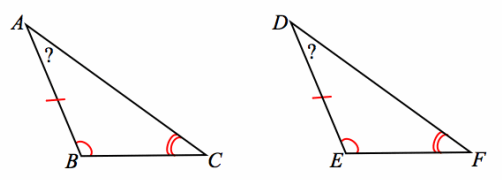
Given this conclusion, which formerly learned triangle congruence criteria can we use to determine if the pair of triangles are congruent?
Answer:
ASA
Therefore, the AAS criterion is actually an extension of the ____ triangle congruence criterion.
Answer:
Therefore, the AAS criterion is actually an extension of the ASA triangle congruence criterion.
Note that when using the Angle-Angle-Side triangle congruence criteria as a reason in a proof, you need only to state the congruence and AAS.
HYPOTENUSE-LEG TRIANGLE CONGRUENCE CRITERIA (HL): Given two right triangles △ABC and △A’B’C’ with right angles B
and B’. If AB=A’B’ (Leg) and AC=A’C’ (Hypotenuse), then the triangles are congruent.
PROOF:
As with some of our other proofs, we do not start at the very beginning, but imagine that a congruence exists so that triangles have been brought together such that A=A’ and C=C’; the hypotenuse acts as a common side to the transformed triangles.

Similar to the proof for SSS, we add a construction and draw \(\overline{\boldsymbol{B B}}^{\prime}\).
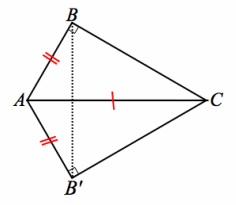
△ABB’ is isosceles by definition, and we can conclude that base angles m∠ABB’=m∠AB’B. Since ∠CBB’ and ∠CB’ B are both the complements of equal angle measures (∠ABB’ and ∠AB’B), they too are equal in measure. Furthermore, since m∠CBB’=m∠CB’ B, the sides of △CBB’ opposite them are equal in measure: BC=B’C’.
Then, by SSS, we can conclude △ABC≅ △A’B’C’. Note that when using the Hypotenuse-Leg triangle congruence criteria as a reason in a proof, you need only to state the congruence and HL.
Criteria that do not determine two triangles as congruent: SSA and AAA
SIDE-SIDE-ANGLE (SSA): Observe the diagrams below. Each triangle has a set of adjacent sides of measures 11 and 9, as well as the non-included angle of 23°. Yet, the triangles are not congruent.

Examine the composite made of both triangles. The sides of length 9 each have been dashed to show their possible locations.
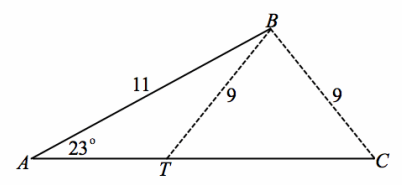
The triangles that satisfy the conditions of SSA cannot guarantee congruence criteria. In other words, two triangles under SSA criteria may or may not be congruent; therefore, we cannot categorize SSA as congruence criterion.
ANGLE-ANGLE-ANGLE (AAA): A correspondence exists between △ABC and △DEF. Trace △ABC onto patty paper, and line up corresponding vertices.
Based on your observations, why isn’t AAA categorized as congruence criteria? Is there any situation in which AAA does guarantee congruence?
Even though the angle measures may be the same, the sides can be proportionally larger; you can have similar triangles in addition to a congruent triangle.
List all the triangle congruence criteria here:
Answer:
SSS, SAS, ASA, AAS, HL
List the criteria that do not determine congruence here:
Answer:
SSA, AAA
Eureka Math Geometry Module 1 Lesson 25 Problem Set Answer Key
Use your knowledge of triangle congruence criteria to write proofs for each of the following problems.
Question 1.
Given: \(\overline{A B}\) ⊥\(\overline{B C}\) ,\(\overline{D E}\) ⊥\(\overline{E F}\) ,\(\overline{B C}\) || \(\overline{E F}\) ,AF=DC
Prove: △ABC≅ △DEF

Answer:
\(\overline{A B}\) ⊥\(\overline{B C}\) Given
\(\overline{D E}\) ⊥\(\overline{E F}\) Given
\(\overline{B C}\) || \(\overline{E F}\) Given
AF=DC Given
m∠B=m∠E=90° Definition of perpendicular lines
m∠C=m∠F When two parallel lines are cut by a transversal, the alternate interior angles are equal in measure.
FC=FC Reflexive property
AF+FC=FC+CD Addition property of equality
AC=DF Segment addition
△ABC ≅ △DEF AAS
Question 2.
In the figure, \(\overline{P A}\) ⊥\(\overline{A R}\) and \(\overline{P B}\) ⊥\(\overline{R B}\) and R is equidistant from \(\overleftrightarrow{\boldsymbol{P A}}\) and \(\overleftrightarrow{\boldsymbol{P B}}\). Prove that \(\overline{P R}\) bisects ∠APB.
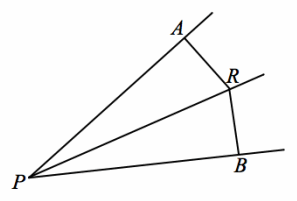
Answer:
\(\overline{P A}\) ⊥\(\overline{A R}\) Given
\(\overline{P B}\) ⊥\(\overline{B R}\) Given
RA=RB Given
m∠A=m∠R=90° Definition of perpendicular lines
△PAR, △PBR are right triangles. Definition of right triangle
PR=PR Reflexive property
△PAR≅ △PBR HL
∠APR≅∠RPB Corresponding angles of congruent triangles are congruent.
\(\overline{P R}\) bisects ∠APB. Definition of an angle bisector
Question 3.
Given: ∠A≅∠P, ∠B≅∠R, W is the midpoint of \(\overline{A P}\)
Prove: \(\overline{R W}\) ≅ \(\overline{B W}\)
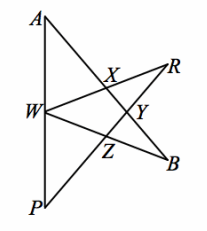
Answer:
∠A≅∠P Given
∠B≅∠R Given
W is the midpoint of \(\overline{A P}\) . Given
AW=PW Definition of midpoint
△AWB ≅ △PWR AAS
\(\overline{R W}\) ≅\(\overline{B W}\) Corresponding sides of congruent triangles are congruent.
Question 4.
Given: BR=CU, rectangle RSTU
Prove: △ARU is isosceles
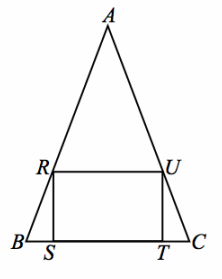
Answer:
BR=CU Given
Rectangle RSTU Given
\(\overline{B C}\) || \(\overline{R U}\) Definition of a rectangle
m∠RBS=m∠ARU When two para. lines are cut by a trans., the corr. angles are equal in measure.
m∠UCT=m∠AUR When two para. lines are cut by a trans., the corr. angles are equal in measure.
m∠RST=90°, m∠UTS=90° Definition of a rectangle
m∠RSB+m∠RST=180 Linear pairs form supplementary angles.
m∠UTC+m∠UTS=180 Linear pairs form supplementary angles.
m∠RSB=90°,m∠UTC=90° Subtraction property of equality
△BRS and △TUC are right triangles. Definition of right triangle
RS=UT Definition of a rectangle
△BRS ≅ △TUC HL
m∠RBS=m∠UCT Corresponding angles of congruent triangles are equal in measure.
m∠ARU=m∠AUR Substitution property of equality
△ARU is isosceles. If two angles in a triangle are equal in measure, then it is isosceles.
Eureka Math Geometry Module 1 Lesson 25 Exit Ticket Answer Key
Question 1.
Sketch an example of two triangles that meet the AAA criteria but are not congruent.
Answer:
Responses should look something like the example below.
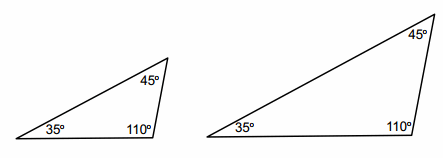
Question 2.
Sketch an example of two triangles that meet the SSA criteria that are not congruent.
Answer:
Responses should look something like the example below.
